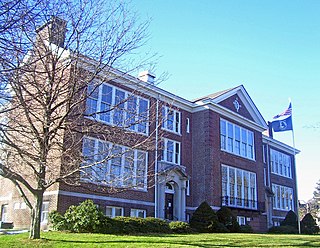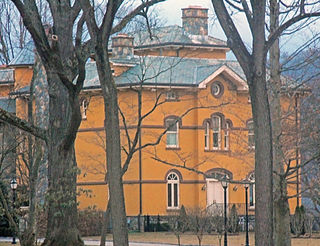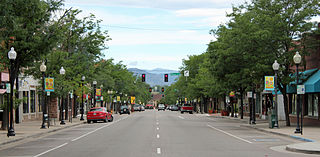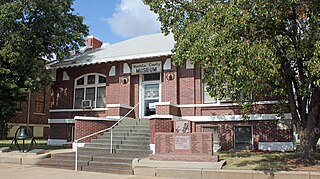
The Bateman Hotel, previously known as Howell Hotel or Kellogg Hotel, located in Lowville, New York, is now a conglomerate of condos. At one time, it was a hotel with a kitchen, a dining room, and a saloon. The hotel is listed in the National Register of Historic Places.

Hughes School is a historic school building near Hamilton, Ohio.

John Vaughan House is a historic house near Shandon, Ohio.

Carlos Avery House is a historic house in the Pittsfield Township, Ohio.

The Willam R. Belknap School is a former school building in the Belknap neighborhood of Louisville, Kentucky United States. It was added to the National Register of Historic Places in 1982. It was designated as a local landmark by the Louisville Metro Landmarks Commission in 2001.

The Chesterton Commercial Historic District is a historic district in Chesterton, Indiana.

US Post Office-Cooperstown is a historic post office building located at Cooperstown in Otsego County, New York, United States. It was built in 1935-1936, and is one of a number of post offices in New York State designed by the Office of the Supervising Architect of the Treasury Department, Louis A. Simon. It is one story in front and two stories in the rear with and exposed basement. It is constructed of brick on a raised concrete foundation and limestone watercourse and beltcourse. The principal facade is symmetrically composed with a three bay pedimented central section faced entirely with ashlar limestone. The building displays Colonial Revival style details. The interior features a 1938 sculpture by artist Bela Janowsky depicting James Fenimore Cooper and two characters from his writings, Chingachgook and Natty Bumpo.

The North Main Street School is located on that street in Spring Valley, New York, United States. It is a brick Colonial Revival building erected in the early 20th century in response to a rapidly increasing school population. Several times since then, it has been expanded. It remained in active use until the 1970s.

Rock Lawn is a historic house in Garrison, New York, United States. It was built in the mid-19th century from a design by architect Richard Upjohn. In 1982 it was listed on the National Register of Historic Places along with its carriage house, designed by Stanford White and built around 1880.

The Littleton Main Street is a historic district located along W. Main Street, from South Curtice Street, to South Sycamore Street in Littleton, Colorado. The district dates from 1890. The nineteenth century buildings are red pressed brick, many with stone foundations and trim. These buildings replaced smaller frame structures from the pioneer era and proclaimed the success of their builders through solid construction and application of exterior ornament.

The Rensselaer Carnegie Library in Rensselaer, Indiana is a building from 1905. It was listed on the National Register of Historic Places in 1994. The building no longer functions as a library; since 1992 it houses the Prairie Arts Council, a local performing arts organization.

St. Luke Building is a historic office building located in Richmond, Virginia. Built in 1902-1903, the St. Luke Building is located on a lot in the southeast corner of a block defined by St. James Street to the east, West Baker Street to the south, St. John Street to the west, and West Charity Street to the north. From the headquarters building, Maggie L. Walker oversaw operations of the Independent Order of St. Luke. Founded in 1869, the Order’s mission to foster African-American economic independence was largely realized under the leadership of trailblazing African American businesswoman Maggie Lena Walker through enterprises housed in the St. Luke Building. The building also housed the St. Luke Herald newspaper, the St. Luke Educational Fund, the St. Luke Penny Savings Bank, and the St. Luke Emporium. Walker was the first African American woman to found a bank in U.S. history, and she leveraged her entrepreneurial success to advocate for African Americans’ civil rights. The office of Maggie L. Walker has been preserved as it was at the time of her death in 1934.

The Covington County Courthouse and Jail is a historic courthouse in Andalusia, the seat of Covington County, Alabama. It was built from 1914 to 1916 along with a jail. Together, the buildings were listed on the National Register of Historic Places in 1989.

The Cordell Carnegie Public Library is a historic Carnegie library located at 105 E. First St. in New Cordell, Oklahoma. The library was built in 1911 through a $10,000 grant from the Carnegie foundation; New Cordell's Commercial Club, which had opened a reading room the previous year, solicited the grant. Architect A. A. Crowell designed the library in the Mission Revival style; several of its elements reflect the emerging Spanish Colonial Revival style. The building's curved parapet walls, exposed rafters, and original red tile roof are all characteristic Mission Revival elements; its segmental arches, sunburst moldings, and ornamental ironwork resemble Spanish Colonial Revival work. The library was the only one in Washita County until the 1960s; it also served as a community center and was regularly used by local schools. In 1982, a new library opened in New Cordell, and the Carnegie Library building became the Washita County Historical Museum.

The Peter Smyth House is a historic house at 1629 Crossover Street in Fayetteville, Arkansas. Built in 1886, it is a regionally rare example of a small stone cottage built in a traditional central hall plan. The house is built out of coursed sandstone, and has finely-chiseled lintels and sills for the openings. The front facade is five bays wide, with a center entry flanked by four sash windows. There two chimneys just inside the outer side walls at the peak of the side gable roof. A stone ell of antiquity similar to that of the house is attached to the rear; it is uncertain whether it was built as an integral part of the house, or added later.

Nappanee Eastside Historic District is a national historic district located at Nappanee, Elkhart County, Indiana. The district encompasses 138 contributing buildings in a predominantly residential section of Nappanee. It was developed between about 1880 and 1940, and includes notable examples of Italianate, Queen Anne, Colonial Revival, and Prairie School style architecture. Located in the district are the separately listed Frank and Katharine Coppes House and Arthur Miller House.

The Winn Road School is a historic school building at the junction of Winn and Range Roads in Cumberland, Maine. Built in 1846, it is one of only two known surviving brick Greek Revival one-room schoolhouses in the state. It was listed on the National Register of Historic Places in 1984.

Hawkswood is a townland in the civil parish of Kinawley, barony of Tullyhaw, County Cavan, Ireland. The original Irish place name was Cluain Caomh meaning 'The Beautiful Meadow'. The town of Swanlinbar is partially situated in Hawkswood. According to the 1938 Dúchas collection two sub-divisions are- The Cleity - A name given to a field in a farm owned by Mr. Patrick Maguire, Hawkswood, Swanlinbar, Co. Cavan. The Rhythars - a name given to a field in a farm owned by Mr Hugh McBrien, Hawkswood, Swanlinbar.

The Checker Cab Building was built as a garage and office building located at 2128 Trumbull Avenue in Detroit, Michigan. It was listed on the National Register of Historic Places in 2019. The building has been rehabilitated into residences, and is now part of the Elton Park lofts.

Great Lakes Manor, also known as Kirby Manor Apartments, is an apartment building located at 457 East Kirby Street in Detroit, Michigan. It was listed on the National Register of Historic Places in 2020.

























